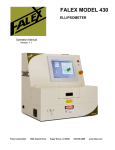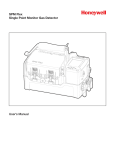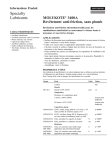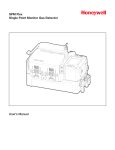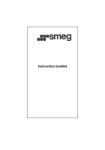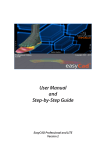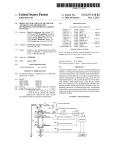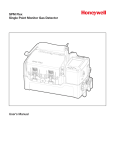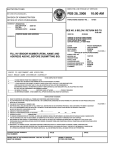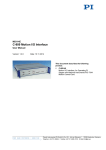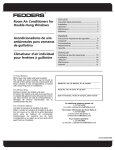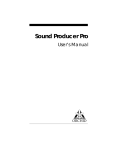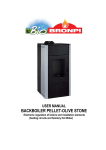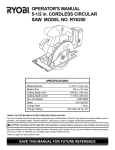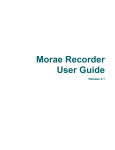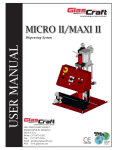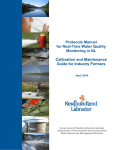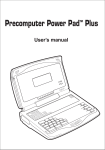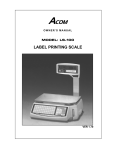Download User Manual - Med-lab
Transcript
FALEX 400 Fuel Thermal Oxidation Test Machine Operation and Maintenance Manual Falex Corporation 1020 Airpark Drive Sugar Grove, IL 60554 630.556.3669 www.falex.com VER 1.1 (1-6-12) F10572_F400Manual.indd 1 2/3/12 9:12 AM Table of Contents 1 Page Forward . Instructions–HowtoUseThisManual. . . . . . . . . . . . . . . . . . . . . . . 3 . .Safety,.Safety.Label.Descriptions.and.Hazardous.Areas.. of.Test.Machine.. . . . . . . . . . . . . . . . . . . . . . . . . . . . . . . . . . . . . . . . . . 3 Section1 GeneralInformation . . . . . . . . . . . . . . . . . . . . . . . . . . . . . . . . . . . . . 5 . 1 .1. Technical.Specifications . . . . . . . . . . . . . . . . . . . . . . . . . . . . . . . . . . . 5 . 1 .2. Brief.Description.of.Equipment. . . . . . . . . . . . . . . . . . . . . . . . . . . . . . 5 . 1 .3. Packing.List. . . . . . . . . . . . . . . . . . . . . . . . . . . . . . . . . . . . . . . . . . . . . 6 . 1 .4. Getting.To.Know.The.Falex.400. . . . . . . . . . . . . . . . . . . . . . . . . . . . . 10 Section2 Setup. . . . . . . . . . . . . . . . . . . . . . . . . . . . . . . . . . . . . . . . . . . . . . . . . 15 . 2 .1. Initial.Setup.. . . . . . . . . . . . . . . . . . . . . . . . . . . . . . . . . . . . . . . . . . . . 15 . 2 .2. Sample.Area.and.Fuel.Preparation. . . . . . . . . . . . . . . . . . . . . . . . . . 15 . 2 .3. Instrument.and.Test.Configuration. . . . . . . . . . . . . . . . . . . . . . . . . . . 17 Section3 SoftwareOperation. . . . . . . . . . . . . . . . . . . . . . . . . . . . . . . . . . . . . 22 . 3 .1. Falex.400.Software.Program. . . . . . . . . . . . . . . . . . . . . . . . . . . . . . . 22 . 3 .2. Run.Test .. .. .. .. .. .. .. .. .. .. .. .. .. .. .. .. .. .. .. .. .. .. .. .. .. .. .. .. .. .. .. .. .. .. .. .. .. .. .. .. .. .. .. .. .. . 23 . 3 .3. Data. . . . . . . . . . . . . . . . . . . . . . . . . . . . . . . . . . . . . . . . . . . . . . . . . . 28 Section4 DisassemblyandComponentCleaning . . . . . . . . . . . . . . . . . . . . 30 . 4 .1. Heater.Tube.Disassembly . . . . . . . . . . . . . . . . . . . . . . . . . . . . . . . . . 30 . 4 .2. Continued.Unit.Disassembly.Cleaning . . . . . . . . . . . . . . . . . . . . . . . 31 . 4 .3. Component.Cleaning. . . . . . . . . . . . . . . . . . . . . . . . . . . . . . . . . . . . . 31 Section5 SoftwarePreferences . . . . . . . . . . . . . . . . . . . . . . . . . . . . . . . . . . . 32 Section6 Maintenance. . . . . . . . . . . . . . . . . . . . . . . . . . . . . . . . . . . . . . . . . . . 34 . 6 .1. Charcoal.Filter.Replacement. . . . . . . . . . . . . . . . . . . . . . . . . . . . . . . 34 . 6 .2. Desiccant.Cartridge.Replacement. . . . . . . . . . . . . . . . . . . . . . . . . . . 34 . 6 .3. Pump.Maintenance.(Prime,.Purge). . . . . . . . . . . . . . . . . . . . . . . . . . 36 Section7 Calibration. . . . . . . . . . . . . . . . . . . . . . . . . . . . . . . . . . . . . . . . . . . . 39 . 7 .1. Thermocouple. . . . . . . . . . . . . . . . . . . . . . . . . . . . . . . . . . . . . 39 . 7 .2. Differential.Pressure. . . . . . . . . . . . . . . . . . . . . . . . . . . . . . . . 40 . 7 .3. System.Pressure. . . . . . . . . . . . . . . . . . . . . . . . . . . . . . . . . . . 41 . 7 .4. Factors . . . . . . . . . . . . . . . . . . . . . . . . . . . . . . . . . . . . . . . . . . 41 F10572_F400Manual.indd 1 2/3/12 9:12 AM Table of Contents Section8 Service. . . . . . . . . . . . . . . . . . . . . . . . . . . . . . . . . . . . . . . . . . . . . . . 42 . 8 .1. Software.Accessible.Service. . . . . . . . . . . . . . . . . . . . . . . . . . . . . . . 42 . 8 .2. Alarm.Log . . . . . . . . . . . . . . . . . . . . . . . . . . . . . . . . . . . . . . . . . . . . . 42 . 8 .3. Fault.Indicators . . . . . . . . . . . . . . . . . . . . . . . . . . . . . . . . . . . . . . . . . 42 . 8 .4. Alarm.and.Warning.Messages . . . . . . . . . . . . . . . . . . . . . . . . . . . . . 43 2 AddendumA PartsListing. . . . . . . . . . . . . . . . . . . . . . . . . . . . . . . . . . . . . . . . . . . 46 AddendumB FileTransferMessage. . . . . . . . . . . . . . . . . . . . . . . . . . . . . . . . . . . 47 Notes: F10572_F400Manual.indd 2 (Blankpageforcustomernotes). . . . . . . . . . . . . . . . . . . . . . . . . . 48 2/3/12 9:12 AM 3 Forward: Instructions–How to Use This Manual This manual provides information and procedures to safely install, operate, and maintain the Falex 400 Thermal Oxidation Test Machine, in future refered to as Falex 400. For your own safety and protection from injury, carefully read, understand and observe the safety instructions described in this manual. Keep this manual with the machine. If you lose this manual or need an additional copy, please contact Falex Corporation. The information contained in this manual was based on machines in production at the time of publication. Falex Corporation reserves the right to change any portion of this information without notice. This operation manual is divided into sections and addenda as listed in the “Table of Contents”. Sections not relevant to this machine will have a page inserted stating so. Safety Introduction The following safety precautions are published for your information. This manual does not purport to detail all of the safety concerns, if any, associated with the equipment’s use. It is the responsibility of the user of this equipment to establish appropriate safety and health practices and determine the applicability of regulatory limitations prior to use. This machine is built with user safety in mind; however, it can present hazards if improperly operated and serviced. Follow operating instructions carefully! If you have questions about operating or servicing this equipment, please contact Falex Corporation. This equipment should only be operated by personnel trained by Falex or a Falex approved distributor. This operation manual contains HAZARD, WARNING, and CAUTION callouts, which must be followed to reduce the possibility of personal injury, damage to the equipment, or improper service. The Falex 400 must be electronically grounded. Do not change the grounding requirements of the instrument. Machine Safety Labels and Manual Safety Callouts The following are safety labels placed in areas on the test machine that may be hazardous to the operator. These same symbols may be used in the manual to bring attention to safety concerns. Please take caution and understand what these labels indicate before operating the test equipment. CAUTION Hot Surface. Do NOT touch. . or Allow to cool before servicing. HOT SURFACE HAZARD: This symbol indicates hot surface areas on the test machine. Use caution when working in these areas where components could be hot. WARNING ELECTRIC SHOCK HAZARD. This equipment is to be serviced by trained personnel only. . or ELECTRICALSHOCKHAZARD:This symbol indicates hazardous voltage is present when opening the electrical cabinet. This unit is to be serviced by trained personnel only. WEAR SAFETY GLOVES: This symbol indicates chemicals that may be hazardous to handle. Wear safety gloves. WEAR BREATHING PROTECTION: This symbol indicates fumes that may be hazardous to inhale. Wear breathing protection. WEAREYEPROTECTION:This symbol indicates eye protection need during operation. F10572_F400Manual.indd 3 2/3/12 9:12 AM Forward: Instructions–How to Use This Manual 4 WARNING FLAMMABLE HAZARD: This symbol indicates the products used are flammable. CAUTION OR WARNING SYMBOL: This symbol indicates a general warning or caution. A caution is important for protecting the equipment and performance. A warning is important to protecting yourself, others, and the equipment. Falex 400 General Safety Warnings . . Desiccant may cause irritation to the eyes or skin. Wear protective goggles and gloves; avoid contact with skin, eyes, and clothing. Use in well ventilated areas and keep away from heat or flame. Follow all Material Safety Data Sheet (MSDS), Hazardous Materials Identification System (HMIS), ISO 9000, Lab Standard Operating Procedures (SOP), and related instructions. Failure to comply may result in personnel injury or death. WARNING WARNING . . . Fuels and solvents are flammable and may cause irritation to the eyes or skin. Wear protective goggles and gloves; avoid contact with skin, eyes, and clothing. Use in well ventilated areas and keep away from heat or flame. Follow all Material Safety Data Sheet (MSDS), Hazardous Materials Identification System (HMIS), ISO 9000, Lab Standard Operating Procedures (SOP), and related instructions. Failure to comply may result in personnel injury or death. F10572_F400Manual.indd 4 The heater tube test section can reach high temperatures of 180 °C–380 °C during a test based upon test configuration. Always place bus bar cover over the heater tube test area when running test to prevent contact with the test section. When the bus bar cover is removed, always assume the heater tube test section is hot and use caution when operating around this area. 2/3/12 9:12 AM 5 Section 1: General Information 1.1 Technical Specifications Machine Weight: 150 pounds Machine Footprint: 16¾ in wide x 20¼ in deep x 30 in high Recommended Working Space: It is recommended that 12in be left on both sides and 6in at the back of the machine. This is to allow the Lexan cover to swing and access to the USB port. Include area needed for cleaning pan. Machine Power: 120V/60Hz 220V/50/60Hz The F400 requires a dedicated service with a ground and a breaker sufficient to supply 10 amps to the 120V units and 5 amps for the 220V units. 1.2 Brief Description Of Equipment The Falex 400 Fuel Thermal Oxidation Test Machine is designed to measure the high temperature stability of gas turbine fuels. It subjects the test fuel to conditions that occur within gas turbine engine fuel systems. It meets ASTM D3241, IP 323 and ISO 6249 standards. It is robust, reliable and compact. ASTM D3241 Thermal Oxidation Stability of Aviation Turbine Fuels requires a strict conformance for the jet fuel industry for this critical test. The Falex 400 matches results due to the critical equipment specification that controls the heater test section and test conditions. The Falex 400 has been designed for years of operation, it provides traceability, long maintenance intervals, and reliable results. Other features of the Falex 400: • Automatic aeration and fuel sequence during an ASTM D3241 test • Priming is simple with easy access and processor control • Certified thermocouples guarantee accuracy This machine utilizes Falex Heater Tube specimens. Falex certifies these tubes meet all of the ASTM D3241 requirements for dimensions, surface finish and material. Falex has proven to meet the requirements of ASTM D3241 through participation and successful completion of an ASTM sactioned equivalency program. Falex Corporation does not guarantee any specific test results or desired functionality of this equipment outside of its intended usage. F10572_F400Manual.indd 5 2/3/12 9:12 AM Section 1: General Information 6 1.3 Packing List 1. The following items are included in the package: • 1 Falex 400 Thermal Oxidation Stability Tester • 1 Start-Up Kit • 1 CD Manual Table 1: Start-Up Kit Contents Quantity 1 Package of 2 Description Part Number Pack of insulation bushings 400-018-003 Bus Bar Drip Pan 400-021-006 1 Package of 5 Charcoal filter 400-025-002 1 Package of 2 Metal Pre-Filter screen 400-027-003 1 Heater tube holder assembly 400-103-009 1 Aeration line assembly 400-105-002 1 F10572_F400Manual.indd 6 Picture 2/3/12 9:12 AM 7 Section 1: General Information Start-Up Kit continued Quantity Part Number 1 Sample output line assembly 400-105-028 1 Fuel heater tube holder input line assembly 400-105-004 1 Fuel heater tube holder output line assembly 400-105-005 1 Pre-Filter assembly 400-105-010 1 Sample input line assembly 400-105-020 1 Lead calibration holder with melted lead 400-108-004 1 Falex 400 Manual CD 400-112-001 1 DP calibration bottle 400-200-005 Heater Tubes with DP filters and O-rings 400-560-001 1 Package of 12 F10572_F400Manual.indd 7 Description Picture 2/3/12 9:12 AM Section 1: General Information 8 Start-Up Kit continued Quantity Description Part Number 1 Package of 25 O-ring tubing 620-005-002 1 Package of 5 O-ring Pre-Filter 620-210-001 2 Beaker, 1000 ml 648-400-012 1 Funnel, large 648-400-003 Funnel filter papers 648-400-011 Pre-Filter filter papers 648-400-005 1 Cleaning brush 648-400-006 1 Hex wrench 648-400-007 1 Cleaning pan, stainless steel 648-400-008 1 Ceramic insulator removal tool 648-400-009 1 Package of 100 1 Package of 25 F10572_F400Manual.indd 8 Picture 2/3/12 9:12 AM 9 Section 1: General Information Start-Up Kit continued Quantity Description Part Number 1 Tweezers 648-400-010 1 Thermocouple - fuel sample 650-009-055 1 Thermocouple - heater tube 650-009-064 1 Power cord 1 Pump priming syringe 650-049-021B 1 Keyboard and Mouse 650-204-048 1 Stylus 650-204-065 1 Mouse Pad 657-100-019 1 Quality Control Certificate of Inspection Picture 650-030-140 (120VAC) or 650-030-150 (220VAC) Oxidation Stability Apparatus Tube Kit p/n 400-560-003 Material: 316 Stainless Steel Form number: 400-111-006 Falex Corporation | 1020 Airpark Drive, Sugar Grove, IL 60554 USA | (630) 556-3669 | f: (630) 556-3679 | www.falex.com CERTIFICATE OF INSPECTION Tube Kit p/n 400-560-003 The enclosed test pieces have been inspected and meet the following requirements: Material: 316 Stainless Steel Manufactured in conformance with: QA Manager: ______________________________ Date: ___________ USA: (630) 556-3669 | [email protected] F10617_PackagingInsert.indd 1 F10572_F400Manual.indd 9 ISO 9001:2000 Europe: +32 (0)16 407 965 | [email protected] 3/1/11 10:09 AM 2/3/12 9:12 AM Section 1: General Information 10 1.4 Getting To Know The Falex 400 Front USB Slot DP Calibration High Alignment Line Desiccant Chamber Door Fault Indicators (Resettable Fuses) Touch Screen Interface On/Off Switch Air Flow Meter Ring Stand Assembly Coolant Flow Meter DP+ Calibration Alignment Line Sample Container Area Sample Test Area Pump Priming Door Figure1 F10572_F400Manual.indd 10 FuelThermalOxidationTester–Front 2/3/12 9:12 AM 11 Section 1: General Information Fans — DO NOT BLOCK Interface Panel USB (2) Ethernet (1) Circuit Breaker Power Plug Receptical Figure2 RearoftheFalex400120VUnit Fans — DO NOT BLOCK Interface Panel USB (2) Ethernet (1) Circuit Breaker Power Plug Receptical Figure3 F10572_F400Manual.indd 11 RearoftheFalex400220VUnit 2/3/12 9:12 AM Section 1: General Information Sample input line assembly 400-105-020 12 Sample output line assembly 400-105-028 Thermocouple - fuel sample 650-009-055 Aeration line assembly 400-105-002 Beaker, 1000 ml 648-400-012 Beaker, 1000 ml 648-400-012 Figure4 SampleContainerArea Aeration line assembly 400-105-002 Sample output line assembly 400-105-028 Sample input line assembly 400-105-020 SampleContainerAreaLines Note.that.the. sample-in.line.is.longer.than.the.aeration.line . Figure5 F10572_F400Manual.indd 12 2/3/12 9:12 AM 13 Section 1: General Information Bus Bar Thermocouple 400-103-004 DP- Port (Out) Thermocouple - heater tube 650-009-057 DP+ Calibration Line DP+ Port (Out) Upper Bus Bar Heater Tube Thermocouple Retaining Clip DP Filter Housing (behind fuel out line) Fuel heater tube holder output line assembly 400-105-005 Fuel Bypass Line Part of 400-103-009 Heater tube holder assembly 400-103-009 Fuel heater tube holder input line assembly 400-105-004 Pre-Filter assembly 400-105-010 Lower Bus Bar Pre-Filter Bulkhead Figure6 F10572_F400Manual.indd 13 SampleTestArea 2/3/12 9:12 AM Section 1: General Information 14 Heater Tube Holder Assembly Hex Nut 977-438-001 Upper insulation bushing 400-018-003 O-ring 650-008-002 Lower insulation bushing 400-018-003 Fuel heater tube holder output line assembly 400-105-005 Bypass Line (part of heater tube holder assembly) Lower insulation bushing 400-018-003 DP Filter Housing (part of heater tube holder assembly) O-ring 650-008-002 Upper insulation bushing 400-018-003 Heater Tube Holder Assembly Hex Nut 977-438-001 Heater tube holder assembly 400-103-009 Figure7 ComponentsForAssemblyofTestSectionArea Pre-Filter Screws Lower Pre-Filter Cover Assembly 400-105-014 O-ring Pre-Filter 620-210-001 Pre-Filter filter paper 648-400-005 Metal Pre-Filter screen 400-027-003 Upper Pre-Filter Cover Assembly 400-105-021 Fuel heater tube holder input line assembly 400-105-004 Figure8 F10572_F400Manual.indd 14 ComponentsForAssemblyofPrefilter 2/3/12 9:12 AM 15 Section 2: Setup 2.1 Initial Setup 1. Plug the Power Cord into the rear of the Falex 400. NoTe: The sample thermocouple can be stored in the hole at the left of the beaker area when not in use [Figure 10]. 2. Plug the power cord (120V, 60Hz, 220V, 50/60Hz) into an appropriate outlet. Electrical source must have a good ground or an isolated power with ground. 2. Grasp the ring stand assembly and pull from the housing [Figure 11a]. After the ring stand assembly is fully extended from the housing, rotate to the right to lock into position [Figure 11b]. 3. Connect a Printer to one of the USB or Ethernet port on the rear of the machine. See page 31 for instructions to load printer driver. 3. Place the funnel into the ring stand and place a clean filter paper into the funnel [Figure 12]. 4. Turn the unit on (by the the rocker switch on the front of the unit) and allow to warm up for 15 minutes prior to use. 5. The Falex 400 is shipped with a charcoal filter located in the beaker stand. Remove the shipping filter by sliding the filter out of the opening on the left side of the beaker stand and replace with a new filter. It is recommended that this filter be replaced every 2 weeks to 1 month depending on usage. See section 7.1 for charcoal filter replacement instructions. 2.2 Sample Area And Fuel Preparation Sample Thermocouple Sample-In Line Aeration Line Glass Beaker Setup will take approximately 20 min. 1. Place a clean, empty glass beaker in the samplein position at the left of the sample container area. Connect the aeration line and the sample-in line to the appropriate fittings on the front panel [Figure 9]. Fittings should be finger tight. Place the aeration and sample-in lines into the glass beaker, letting end of sample-in line rest on bottom of beaker. Plug in the sample thermocouple and place the thermocouple into the glass beaker. Figure10 ThermocoupleStorage Filter Paper Figure9 Sample-InBeakerArea Figure11a RingStandAssembly Figure11b RingStandAssembly Funnel Ring Stand Figure12 F10572_F400Manual.indd 15 Funnel/Filter Setup 2/3/12 9:12 AM Section 2: Setup New O-ring 16 Damaged O-ring Figure14a O-ringInspection Figure14b O-ringPlacement Beaker Filter/Funnel Figure13 FilteringFuel WARNING . . . Fuels and solvents are flammable and may cause irritation to the eyes or skin. Wear protective goggles, gloves, and an apron; avoid contact with skin, eyes, and clothing. Use in well ventilated areas and keep away from heat or flame. Follow all Material Safety Data Sheet (MSDS), Hazardous Materials Identification System (HMIS), ISO 9000, Lab Standard Operating Procedures (SOP), and related instructions. Failure to comply may result in personnel injury or death. 4. Using the graduations on the side of a clean beaker, pour appropriate amount of fuel into the beaker per the method. A minimum of 500 ml may be used. Slowly add the fuel into the filter/ F10572_F400Manual.indd 16 funnel until all the fuel has been placed into the filter [Figure 13]. Place the now empty beaker in the sample-out position at the right of the sample container area. 5. Place an O-ring on the sample-out line. O-rings are required on all tubing lines except the aeration and sample-in lines. Place a clean small O-ring (650-005-002) at the end of each line before securing the line in place [Figure 14aand14b]. Inspect the O-rings and replace if damaged or missing. 6. Connect the sample-out line to the appropriate fitting on the front panel [Figure 4]. 7. Once the fuel has been filtered, remove the filter and dispose of it according to local regulations. 8. Remove, clean, and store the funnel. 9. Rotate the ring stand assembly to the left and store into the ring stand housing of test machine [Figure 11]. 2/3/12 9:12 AM 17 Section 2: Setup 2.3 Instrument And Test Configuration the riveted end down and the tube ID number closest to the DP filter housing. Secure the heater tube to the top of the heater tube housing using the lower insulator bushing with the flare facing end of tube, O-ring (supplied in the heater tube kit), upper insulator bushing, and hex nut [Figure 15]. Finger tighten loosely. NoTe: Before instrument setup, all components must be clean. If the components are not clean, review the Component Cleaning section [seesection4.3]. A new heater tube, DP test filter and three O-rings are required for each test. 1. Retrieve a new heater tube kit from the box of specimens. 2. Carefully remove the new heater tube from the container. Wear gloves and handle the heater tube by the ends only. Do not touch the center section of the tube. 3. Inspect the center section of the tube for scratches, unpolished areas, or other visual defects. Ensure the tube is not bent by rolling it on a flat surface. If the tube is bent or has other defects, discard that tube and retrieve another kit. It is advisable to write the tube number down as this number is a required entry value on the test configuration setup. 4. Assemble the test section. Insert the heater tube into the heater tube housing so that it is approximately in the center of the housing with 5. Position the heater tube inside the housing by looking though the fuel discharge hole (DP filter housing) and centering the heater tube shoulder in the hole so that the shoulder is lined up with the center of the bypass line [Figure 16]. 6. Secure the heater tube to the bottom of the heater tube housing using the lower insulator bushing with flare facing the end of the tube, O-ring (supplied in heater tube kit), upper insulator bushing, and hex nut. Finger tighten loosely. 7. Finger tighten the hex nuts on both ends of the heater tube housing firmly. NoTice: Overtightening will break the ceramic bushings and can cause leaks. Hex Nut Heater Tube Upper Insulator Brushing O-ring Lower Insulator Housing Heater Tube Housing Heater Tube Shoulder Figure15 F10572_F400Manual.indd 17 HeaterTubeInstallationComponents Figure16 HeaterTubePosition 2/3/12 9:13 AM Section 2: Setup 8. Using clean tweezers, install the DP filter supplied in the heater tube kit into the DP filter housing. Ensure the blue stripe is facing out. If the blue stripe is missing, then that filter has already been used so do not use it [Figure 17a]. A new DP filter must be used for each test. Place a new O-ring, supplied in the heater tube kit, on top of the DP filter and push into place [Figure 17b]. DP Filter 18 DP Filter Housing 9. Attach the large end of the fuel-out line to the DP filter housing [Figure 18]. Finger tighten. 10. Inspect the O-rings on the fuel-out and bypass lines. Replace if missing or damaged. 11. Remove the right retaining screw of each bus bar cap using the hex wrench supplied. Loosen the left retaining screw of each bus bar cap using the hex tool, so that the cap is free to pivot on the screw [Figure 19]. To remove any fuel that may have seeped on to the bus bars, clean the bus bar contacts and bus bar caps, focusing on the portions that comes in contact with the heater tube. Figure17a O-ring DPFilterInstallation DP Filter Housing Attach Fuel-Out Line Onto Assembled DP Housing Fuel-Out Line O-ring Figure17b Figure18 AssembledTestSection Figure19 F10572_F400Manual.indd 18 DPO-ringInstallation RemovingRightBusBarScrew andLooseningLeftScrew 2/3/12 9:13 AM 19 Section 2: Setup NoTe: The bus bar caps and contacts are a matched set. If the caps are completely removed from the contacts, match the number stamped on the inside of each cap to the number stamped on the end of the contact. Bus Bar Caps Bus Bar Contacts 12. Install the assembled test section into the sample test area [Figure 20]. Place the assembled test section in the groove between the bus bar contacts and bus bar caps serial number side up. Insert both right hand retaining screws and loosely finger tighten. Heater Tube 13. Align the top of the heater tube so that it is flush with the top of the bus bar contact [Figure 21]. Assembled Test Section 14. When the test section is properly aligned, tighten the upper and lower bus bar screws with the hexagon wrench provided. 15. Attach the fuel-out line to the DP- fitting and fuel bypass line to the DP+ fittings [Figure 22]. Finger tighten the fittings. Figure20 InsertingTestSectionInstallation Fuel-Out Line To DP- Fitting Fuel Bypass Line To DP+ Fitting Figure21 TubeAlignedWithTopof Figure22 Fuel-OutandFuelBypassLines Bus Bar F10572_F400Manual.indd 19 2/3/12 9:13 AM Section 2: Setup 16. Begin assembling the pre-filter by placing the pre-filter O-ring on the lower housing [Figure 23]. 17. Place the pre-filter screen into the upper housing [Figure 23]. 18. Using clean tweezers, remove a new pre-filter filter paper from the protective case and place onto the pre-filter screen. NoTe: There are two blue paper spacers between each pre-filter filter paper. Do not use blue spacer paper. Use only the white pre-filter element. Use of the blue spacer paper will cause the test to fail. 20 Place the lower housing onto the upper housing. Line up the screw holes on the upper and lower housings and insert the screws through the lower housing into the upper housings [Figure 23]. Finger tighten the screws with the hexagon wrench. 19. Inspect the O-ring on the end of the pre-filter assembly. Replace the O-ring if missing or damaged. 20. Connect the pre-filter assembly to the pre-filter bulkhead fitting and finger tighten [Figure 24]. Pre-Filter Screws Lower Pre-Filter Housing Pre-Filter O-ring Pre-Filter Bulkhead Fitting Pre-Filter Assembly Pre-Filter Paper Filter Pre-Filter Metal Screen Upper Pre-Filter Housing Fuel Input Line Figure23 F10572_F400Manual.indd 20 Pre-FilterComponents AttachingthePre-Filter Assembly Figure24 2/3/12 9:13 AM 21 Section 2: Setup 21. Attach the pre-filter assembly to the assembled test section using the fuel input line [Figure 25]. Inspect the O-rings on both ends of the sample line union. Replace if missing or damaged. NoTe: The heater tube thermocouple can be stored in the hole found on the top right of the beaker stand to the left of the bus bar area when not in use [Figure 26b]. 24. Check all of the fittings to ensure they are finger tight. 22.Finger tighten the fittings until snug. 23. Plug in the heater tube thermocouple. Carefully insert the thermocouple tip into the hole on the top of the heater tube and lower until it stops. Rotate the thermocouple retaining clip to the left to lock the thermocouple into place [Figure 26aand26b]. 25. Close the acrylic cover to the sample test area. Leaving the cover open will cause an alarm while a test is running. If this is the initial setup or if the F400 has not been operated for 15 days it is recommended that the automated Purge be run prior to any tests being performed on the unit. Refer to section 6.3.2. Assembled Test Section Fuel Input Line Pre-Filter Assembly FuelInputLinetoAssembled TestSection Figure25 Thermocouple Retaining Clip Figure26a F10572_F400Manual.indd 21 Insert Thermocouple into top of Tube ThermocoupleRetainingClip Retaining Bus Bar Screws Clip in Place Heater Tube Thermocouple Installed HeaterTubeThermocoupleand RetainingClip Figure26b 2/3/12 9:13 AM Section 3: Software Operation It is recommended that the user familarize themself with the software by reading this section prior to using any portion of it. 3.1 Falex 400 Software Program GeNeral NoTes: Various software screens have similar buttons which are discussed below. HEADER:Each screen has a blue shaded header. The center of the header has the screen title with the date and time displayed underneath. The time is shown in standard or military format depending on the user preference. The headers right side may have an abort button or a home button. The home button returns to the Main screen while the abort button will end the current process. The ‘?’ invokes the software version builds on the main screen [Figure 28]. The '?' invokes a reference for help on all other screens [Figure 27]. Screen Title Date & Time Lower right corner buttons: Usually there is a backward arrow, forward arrow or both [Figure 29]. The backward arrow directs the user to the previous screen and the forward arrow advances to the next screen. In many instances the forward arrow will not appear until certain conditions are met on the current screen (such as; mandatory test information entered, a button pushed, a temperature value reached). Lowerleftcornerbuttons: Buttons in the lower left are for user assistance [Figure 29]. Various screens during a running test have a “Status’ button which activates a Status screen. The Status screen shows live feedback of critical test data and where that data is taken from. Return to Main Screen (Figure 28) Software build or Operational Manual Help (Figure 29) Aborts test or procedure Figure27 HeaderBars Figure28 SoftwareBuild F10572_F400Manual.indd 22 22 Help Location in Operation Manual 2/3/12 9:13 AM 23 Section 3: Software Operation Instructions Forward screen and back screen buttons Figure29 LowerLeftandRightButtons The ‘RUN TEST’ menu allows users to choose various test types and record the visual tube reading. The test data can be viewed, printed, and/or stored after a successful test completion. 1. AccessingtheTestTypescreen: On the MAIN SCREEN press the 'Run Test' button [Figure 31]. If this button is not visible there will be a temperature bar in its place [Figure 32]. This bar shows the current heater tube thermocouple temperature and will not allow an operator to start a new test until the temperature drops below 40ºC, at which time it is safe to remove the old heater tube and set up for a new test. The heater tube test section is extremely hot and dangerous to handle during and after a test has completed or aborted. Keep the thermocouple in the heater tube after any test has completed or aborted until its temperature drops below 40ºC. Once the temperature is below 40ºC the unit is safe to handle. The ‘Instructions’ button pops up a window to help explain how the current procedure is run [Figure 30]. These instructions are basic and the user should refer to other sections in this manual for a more detailed explanation on that particular procedure. Some instructions may have multiple pages and the arrow in the lower right corner takes you to additional instructions. Press the ‘Close’ button to exit the instructions and return to the program. Access Test Sleection Screen Additional pages MainScreenIn ReadyState Figure31 Figure30 AdditionalPageArrow onInstructionPages Temperature must be below 40ºC before ‘Run Test’ button appears Throughout various screens will be 'factory' buttons. ‘Factory’ buttons are solely for the use of authorized factory personnel and access to this area is protected. 3.2 Run Test If this is the inital setup or if the unit has not been operated for 15 days it is recommended that the automated Purge be run prior to any tests being performed on the unit. Refer to section 6.3.2. F10572_F400Manual.indd 23 Figure32 MainScreenWaitingForHeater TubeTemperaturetoLower 2/3/12 9:13 AM Section 3: Software Operation 2. TestTypeScreen: This screen has the possibility of eight different test types to choose from [Figure 33]. The D3241 ASTM test is always active and the button cannot be deactivated. Single, Breakpoint 1, Breakpoint 2, and the 4 Custom tests are activated from the ‘Preference’ screen. Active NoTe: Only tube rating entries of 0, <1, 1, <2, 2, <3, 3, <4, and 4 are accepted for the breakpoint tube reading. D. Breakpoint2: Breakpoint 2 runs a matrix of tests checking both the visual tube reading value (numeric, abnormal and peacock) and the maximum ΔP value. All tests run 150 minutes. NoTe: At the time of this printing Breakpoint 2 is not included in the test series matrix. E. Custombuttons1-4: Custom 1-4 buttons allow the user to store both the test header information and the test parameters as a unique test name. This information is retained with the button selection until it is overwritten. Selecting a test type will advance to the respective configuration screen Inactive Figure33 NewScreenShot A. ASTM: A D3241 test commences following the mandatory test information entry. All tests are 150 minutes with a flow rate of 3ml/minute. These values cannot be altered. The temperature default to the value set under ‘Preferences’ and can only be altered through the ‘Preferences’ screen. B. Singletests: This selection allows the operator to set parameters for test duration, flow rate and test temperature for one run. The parameters entered are not stored. C. BreakPoint1: Breakpoint 1 runs a series of automated tests, sequencing from the visual tube reading numeric value only. It does not consider the visual tube reader entry of abnormal or peacock and does not consider the differential pressure (ΔP). All tests run 150 minutes. Configuration allows for the operator to choose the initial control temperature (between 180–380ºC) for the series of tests. The operator enters a tube rating value for each test in the series and the program automatically sets up the parameters for the next test. Each subsequent test will automatically increment 10ºC if the entered tube reading is <3. There is one exception to the automated temperature increase and that is on the second run. The operator is given the chance to reenter his starting temperature to a higher value if he feels the initial temperature setting was too low. Once a reading of 3 or greater is entered the final test in the series is initiated at a temperature of 5ºC below the previous run. All results are compiled into a single data file. F10572_F400Manual.indd 24 24 3. ConfigurationScreens: All test types require configuration prior to starting. Data File Root Name, Lab, Operator, Tube ID Fuel Type and Fuel ID fields can be entered by the operator, however tube ID and the Fuel ID must be entered before the configuration screen will display a forward arrow allowing program advancement [Figure 34]. Some test configurations allow for entry of test duration, flow rate and test temperature. All four custom configuration screens have one additional entry field for the button name. Information entered in the Configuration screens is considered the header for the generated data files and will appear on both the printed report and the electronic file. The back arrow at the bottom right returns to the ‘Test Type’ screen. The forward arrow on the bottom right will only appear once the mandatory configuration information has been entered. The Instructions button on the lower left opens a window with generic instructions for setting up and running a test. Please refer to the method for specific instructions. Figure34 ASTMConfigurationScreen 2/3/12 9:13 AM 25 Section 3: Software Operation A. DataFileRootName: The Data File Root Name can be entered (maximum of 6 characters) or left with the default value. Every time any configuration screen is entered the Data File Root Name is Data. This can be overwritten. Every test run has a sequential number added to the root name. Once any combination of 99 tests are run, the sequential number resets to 01. B. Lab: A lab name may be entered up to 15 characters in length. Figure35 SingleConfiguration C. Operator: An operator name may be entered up to 15 characters in length. D. TubeID: A tube ID entry is a mandatory entry, The value can not exceed 15 characters. The tube ID number can be found on the specimen tube. E. FuelType: An fuel type may be entered up to 15 characters in length. F. Figure36 Breakpoint/Configuration FuelID: A fuel ID entry is required. It may be up to 15 characters in length. G. TestTemperature,C: Enter a temperature. The test will control the temperature of the tube between 180–380˚C. Single, breakpoint and custom test configurations allow this to be an operator entry but on ASTM tests this is a fixed value. H. Duration,min: Enter a time for the test duration between 9-360 minutes. The timer begins once the unit has reached the temperature set point. Single and custom configurations allow this to be an operator entry but is a fixed value in both ASTM tests and breakpoint tests. I. Figure37 Figure38 F10572_F400Manual.indd 25 CustomConfiguration FlowRate,ml/min: Enter a pump flow rate between 2–9 ml/minute. Single, breakdown and custom configurations allow this to be an operator entry but it is a fixed value for an ASTM test. 4. AerationScreens: Proceeding from the configuration screen the aeration screen appears [Figure 38]. The user has the choice to start aeration or skip aeration. AerationScreen 2/3/12 9:13 AM Section 3: Software Operation 26 NoTe: According to D3241 aeration most take place within 1 hour prior to heating the sample. If the operator chooses to skip aeration a warning box will appear reminding of the 1 hour requirement. Be sure to properly assemble the Falex 400 before proceeding. Begin the aeration process by pressing the ‘Start’ button. An aeration timer begins counting the 6 minutes that the aeration pump is on. Bubbles will appear in the sample beaker from the aeration line filter. Aeration rate is at about 1.5 L/minute when the ball is set in the middle of the green area on the aeration flow meter on the front of the unit. Adjust the meter as required [Figure 39]. During aeration, the sample temperature should be held between 15–32ºC and the aeration humidity to no greater than 21%. Should the sample temperature or humidity be outside of this range the test will abort. The current values for temperature and humidity appear in the center Data box on the screen. The Digital Points then displays status within the system during aeration. The ‘Status’ button in the lower left corner opens a pictorial screen of the F400 showing live values of critical measurements [Figure 40]. 5. The test will automatically begin after the 6-minute fuel aeration. As the sample is being aerated, the previous runs fuel is purged from all lines and valves. Aeration Flow Meter Coolant Flow Meter Figure39 F10572_F400Manual.indd 26 Figure40 StatusScreen 6. During the aeration, inspect all fittings in the sample test area for leaks. 7. If leaks are found, re-tighten using fingers only. 8. TestScreens: These screens remain open the duration of a test. The Pressure box in the lower right indicates the system pressure and the DP value. Tests run at 3.45MPa+/- 10%. Once system pressure is reached the heater will commence. It is recommended that the operator watch for leaks during this pressurization. When leaks are visible, abort the test, tighten all fittings and restart the test. Should the unit not reach required pressure within 180 seconds the system will abort. After the required pressure is reached the heater tube temperature will increase. A system abort will automatically happen if the heater tube temperature set point is not reached within 90 seconds after the 3.45MPa pressure is reached. Likewise, if the temperature is not held within two degrees of the set point a system abort will be triggered. When the set point temperature is reached (Indicated in the Temperature box on the right) the test run timer starts. 9. The bus bars are cooled once heating of the tube begins. The coolant flow meter should be adjusted to 10 gal/hr flow [Figure 39]. The bar at the bottom of the screen gives graphical feedback of the test run time [Figure 41a]. The “+” button on the top right will open a graph with the DP, system pressure and heater tube temperature overlapping [Figure 41b]. AerationCoolantMeters 2/3/12 9:13 AM 27 Section 3: Software Operation Figure41a Testruntime Systempressureandheater tubetemperature Figure41b 10. TestCompletion: Tests either complete or they fail due to operator aborts, failure to meet or maintain operational requirements such as pressure loss, failure to maintain temperature or excessive bus bar temperature. Following test completion or failure, a safety screen appears halting program advancement until a safe handling temperature is reached at the heater tube thermocouple [Figure 42]. The Tube Temperature timer bar will disappear from the Test Complete screen when the unit has reached a safe temperature to proceed. The heater tube test section is extremely hot and dangerous to handle after a test has completed or aborted. Keep the thermocouple in the heater tube after any test has completed or aborted until its temperature drops below 40ºC. Once the temperature is below 40ºC the unit is safe to handle. F10572_F400Manual.indd 27 Figure42 TestCompletionScreenWaiting ForTubTemperatureToCool A. TubeRating: Upon a successful test completion a tube rating screen appears following the cool down. Follow the heater tube disassembly procedure (Section 4) to prepare the tube for rating. The operator can enter a value for the tube rating and pumped fuel volume or advance without entries [Figure 43]. All entries are stored with the data file. The tube rating is derived from placing the specimen tube in the Falex 420 Tube Rater and comparing it to the ASTM D3241 color comparison standard supplied with the Tube Rater. The Falex 420 Tube Rater is specifically designed to meet ASTM D3241 for tube rating. Any characters can be entered for a tube rating however if is recommended that the individual test method for procedure and instructions on how to rate a tube be used. Figure43 TubeRatingScreen B. AbortedTests: A test is terminated by the operator pressing any abort button during a test or from the test itself failing to reach defined parameters. Refer to the Alarm section of this manual to see which alarms cause an immediate test termination and which alarms initiate only a warning message. 2/3/12 9:13 AM Section 3: Software Operation 3.3 Data Data: The ‘Data’ screen is accessed from the ‘Main’ screen [Figure 44] or it will automatically appear at the completion of a successful test. The ‘Data’ menu allows the user to retrieve the data file from the last test whether successfully completed or not. 28 1. View: This initiates a display of the printout information from the last run test. There are two screens. The first ‘View Data –General’ screen displays test information on the test [Figure 46]. Press the forward arrow to advance to the “View Data-Pressure” screen to see the DP readings taken every 30 minutes during the test [Figure 47]. NoTe: If the Falex 400 has had a power cycle since the last test, data transfer cannot be performed. The name of the last test run is on the top line on this screen. This is the file that the first three buttons refer to [Figure 45]. The user can view the test data on the touch screen, transfer the data from the PLC storage onto the computer, print this report and/or copy files from the touch screen to a USB device or Ethernet connection. Complete data records of DP mmHg, heater tube temperature and system pressure are taken every minute during a test and are stored in the data file. To retrieve the data file the operator needs to ‘Transfer’ the data file and then ‘Copy’ the file to an external folder. Data files are saved in .csv format and can be viewed using appropriate software. Figure46 ViewingData Page1-TestInformation Figure47 ViewingData Page2-DPValues Access the data Figure44 HowToAccess TestData Figure45 DataFileName Name of data file that View, Transfer and Print refer to F10572_F400Manual.indd 28 2/3/12 9:13 AM 29 Section 3: Software Operation 2. Transfer: After a test completion this button MUST be selected to move the test data to the computer. Upon transfer, data files reside in the “Data” folder under the root directory (F400 (C:)). An acknowledgement window appears upon successful data transfer [Figure 48]. Do not proceed until this acknowledgement appears. NoTe: The current test data will be lost at the start of the next test if this ‘Transfer’ button is not pressed or when the F400's power is cycled. The computer has limited hard drive space and it is recommended that the user regularly perform file maintenance on the “Data” folder . 4. Copy: ‘Copy’ opens Windows Explorer. Navigate to the “Data” folder under the root directory (400 (C:)). This folder contains all the data files that have been transferred. Close Windows Explorer when copying is complete. For copying to external devices there are three USB ports and one Ethernet port located on the 400. Two USB ports and the Ethernet port are on the convenience outlet on the back panel. One USB port is located on the front of the unit directly above and to the right of the drierite window. NoTe: Do not delete or rename the Data folder or data transfer will not occur and test data information will be lost. 3. Print: Pressing the print button sends the data file to the installed printer. An internal message appears while the data transfer is in process and will close automatically, sample can be seen in printout [SeeAddendumB]. Falex recommends using the printer sold by Falex as the drivers are installed and ready for use upon power up. Should a different printer be used refer to the ‘Preference’ section of this manual to install a printer. Figure48 F10572_F400Manual.indd 29 FileTransferMessage 2/3/12 9:13 AM Section 4: Disassembly and Component Cleaning WARNING . . . Fuels and solvents are flammable and may cause irritation to the eyes or skin. Wear protective goggles, gloves, and an apron; avoid contact with skin, eyes, and clothing. Use in well ventilated areas and keep away from heat or flame. Follow all Material Safety Data Sheet (MSDS), Hazardous Materials Identification System (HMIS), ISO 9000, Lab Standard Operating Procedures (SOP), and related instructions. Failure to comply may result in personnel injury or death. 30 9. Remove the test section assembly. 10. Remove the fuel-out line (J-line) from the heater tube housing and place in the pan provided. 11. Remove the O-ring and the DP filter from the DP filter housing using the extraction tool provided. Discard the used O-ring and the DP filter. 12. Remove the hex nuts and the upper insulator bushings from both sides of the heater tube housing and place them in the pan provided. Remove and discard the O-rings. 13. Remove the lower insulator bushings from both sides of the heater tube and the heater tube housing and place them in the pan provided. 14. Carefully slide the heater tube out of the housing. NoTe: Lower insulator bushings may come out of the heater tube housing while removing the heater tube or they may stay in the heater tube housing. Take care not to lose them. The heater tube test section can reach high temperatures of 180 °C–380 °C during operation. Always place bus bar cover over the heater tube test area when running test to prevent contact with the test section. When the bus bar cover is removed, always assume the heater tube test section is hot and use caution when operating around this area. 15. Rinse the heater tube with Iso-Octane and allow the solvent to evaporate. Place the heater tube back in the original plastic container and cap until you are ready to rate the tube. 16. Rate the tube using an approved method and record value on screen. 4.1 Unit Disassembly 1. Position a waste solvent container as needed to catch solvent during the component cleaning. 2. The heater tube must be removed and rated. Allow the heater tube assembly to cool for 15 minutes before continuing. 3. Lift and rotate the heater tube thermocouple retaining clip off the thermocouple and carefully remove the thermocouple tip from the hole on the top of the heater tube taking care not to bend the thermocouple. 4. Wipe down the thermocouple using a germicidal wipe. Upper And Lower Bus Bar Screws 5. Remove the fuel-out line from the DP- fitting and the fuel bypass lines from the DP+ fittings. 6. Remove the prefilter assembly from the cabinet bulkhead. 7. Remove the right upper and lower bus bar screws with the hex wrench provided [Figure 49]. 8. Loosen the left hand screws on the upper and lower bus bars but do not remove [Figure49]. F10572_F400Manual.indd 30 Figure49 RemovaloftheTestSection 2/3/12 9:13 AM 31 Section 4: Disassembly and Component Cleaning 4.2 Continued Unit Disassembly 17. Use the hex wrench to remove the three screws in the pre-filter assembly. 18. Disassemble the pre-filter. Remove and discard the white pre-filter element. Place the remaining components of the pre-filter assembly into the provided pan. The prefilter O-ring is reusable afer proper cleaning. 19. Open the cover from the sample container area. 20. Remove the aeration line and the sample-in line and place them in the pan provided. 21. Remove the fuel thermocouple from the beaker and wipe down. 22.Remove the sample-in and sample-out glass beakers. 4.3 Component Cleaning NoTice: The heater tube housing is the only component to be cleaned with Tri-Solvent. 1. Brush the inside of the heater tube housing with the provided cleaning brush and Tri-Solvent. 2. Inspect the inner surfaces of the heater tube housing for cleanliness and repeat step 1 if needed. 3. Rinse with Iso-Octane and dry using compressed air. 4. Use a wash bottle filled with Iso-Octane to flush/ rinse all components in the pan and dry using compressed air. Make certain all fuel has been removed from all components. 23. Dispose of fuel appropriately according to local regulations. F10572_F400Manual.indd 31 2/3/12 9:13 AM Section 5: Software Preferences 32 5.0 Software Preferences The Preferences menu allows authorized users to set up which test types can be run, the default ASTM D3241 test temperature, date/time display options (military or standard time), and exit to Windows to install printer drivers. Only authorized users should be given the password to the Preference section. 1. AccessingthePreferencesscreen: On the MAIN SCREEN press the 'Preferences' button [Figure 50]. A pop-up box will appear on the screen asking for a password. Enter the password and press OK to continue. Access Preferences Figure51 PreferencesScreen A. TestSelection: This section is on the lefthand side of the screen containing seven boxes with respective titles on their right. Clicking on these boxes will put an 'X' in the box and activate the different test buttons available on the TEST TYPE screen. To deactivate a test type, click the boxes once more so that the 'X' disappears from the box. Figure50 Accessing Preferences 2. PreferencesScreen: After the password is entered, the Preference screen appears [Figure 51]. There are four areas to this screen. First there is the 'Test Selection' section to the left-hand side of the screen containing seven test types, a ‘Time’ section containing selections for the date/time format, an ‘Install Printer’ button for access to the Windows Control Panel for adding additional printers, and a value box labeled ‘ASTM Temp, C:’ to set the stored ASTM test temperature. A ‘Single’ test allows the user to enter all the test header information and all the test parameters. A single test runs one test with these parameters. They are not saved when the machine‘s power is cycled. ‘Breakpoint1’ follows the breakpoint method described inn ASTM D3241. It is based only on the VTR (visual tube reader) integer value entered at the completion of each test section. ‘Breakpoint2’ is a matrix method used to determine the fuel’s breakpoint but takes into consideration the VTR readings with the A (abnormal) and P (peacock) attributes and the DP value. The only test parameter the user may enter is the starting temperature. There are four custom tests the user can choose. Each ‘Custom’ test allows the user to enter all the test header information and the test parameters. Once they are entered they are stored in the unit even through power cycles. B. Time: On the right-hand side of the Preferences screen, there is a box labeled 'Time.' In this box, there are two buttons 'Mil' and 'Std.' These stand for 'Military' and 'Standard' time respectively and will change the format of the time display on the machine. F10572_F400Manual.indd 32 2/3/12 9:13 AM 33 Section 5: Software Preferences C. InstallPrinter: Pressing the ‘Install Printer’ button will initiate the Windows Control Panel. Select the 'Printers and Faxes' icon in the Window’s Control Panel and then select 'Add Printer.' Users can also install a printer driver from a flash drive. Printer drivers: Falex does not guarantee the use of any printer with its software other than the one shipped with the unit. D. SetPCTime: This button takes you out to Windows Control Panel that allows you to navigate to Date & Time. Once you have set the correct date and time, cycle the power by turning the unit off and then on. E. ASTMTemperature: This is where a default test temperature can be stores for all ASTM tests. For instance, some specifications require 270ºC rather than the default value of 260ºC. F10572_F400Manual.indd 33 2/3/12 9:13 AM Section 6: Maintenance 6.1 Charcoal Filter Replacement 34 Desiccant Cover To prevent equipment contamination, the charcoal filter must be changed monthly. Failure to follow this warning may result in damage to equipment. 1. Ensure the Falex 400 is not performing a test. 2. Open the beaker cover by tilting it out towards you. 3. Slide the used charcoal filter out of the slot on the left side of the beaker stand [Figure52]. 4. Properly dispose of the charcoal filter. 5. Slide a new charcoal filter into the slot on the left side of the beaker stand. Figure53 DesiccantCartridgeLocation DO NOT use the ethernet port in the desiccant chamber. It is for use by Falex technicians only. 1. Change the desiccant cartridge when 75–90% most of the desiccant granules turn from blue to pink. Figure52 Charcoal Filter 6.2 Desiccant Cartridge Replacement . 2. Be sure the Falex 400 is powered off. Locate the desiccant cover on the front of the Falex 400 [Figure53]. 3. While holding the desiccant cover in place, use a flat-tipped screwdriver to loosen six flathead screws until the cover can be removed [Figure54]. These screws are captivated and will not come apart from the cover. . Desiccant may cause irritation to the eyes or skin. Wear protective goggles, gloves, and an apron; avoid contact with skin, eyes, and clothing. Use in well ventilated areas and keep away from heat or flame. Follow all Material Safety Data Sheet (MSDS), Hazardous Materials Identification System (HMIS), ISO 9000, Lab Standard Operating Procedures (SOP), and related instructions. Failure to comply may result in personnel injury or death. Figure54 F10572_F400Manual.indd 34 DesiccantCartridgeMountedIn Housing 2/3/12 9:13 AM 35 Section 6: Maintenance 4. Grasp the desiccant cartridge with one hand and pull the desiccant cartridge straight out of the machine. If rubber bushings are attached to desicant filter, remove and replace in machine [Figure55]. Properly dispose of used desiccant cartridge. 5. Obtain a new desiccant cartridge [Figure56]. 6. Align the new desiccant cartridge with the desiccant cartridge inlet/outlet ports. Push the desiccant cartridge straight into the F400 desiccant housing until the cartridge snaps into the retainer clips. 7. Power on the machine, and proceed to maintenance screen. Push the aeration button. Verify the humidity level is dropping. If it is not, the dessicant is not seated correctly in the rubber bushing. Remove dessicant cartridge, reposition rubber bushing and reinstall cartridge. Figure56 DesiccantCartridge 8. Once the cartridge is properly installed. replace desiccant cover and install six screws to secure. Desiccant Housing Retainer Clips Desiccant Cartridge Inlet/Outlet Ports Rubber Bushings Figure55 F10572_F400Manual.indd 35 DesiccantCartridgeHousing 2/3/12 9:13 AM Section 6: Maintenance 6.3 Pump Maintenance 6.3.1 Prime Pump WARNING . . . 36 . Fuels and solvents are flammable and may cause irritation to the eyes or skin. Wear protective goggles, gloves, and an apron; avoid contact with skin, eyes, and clothing. Use in well ventilated areas and keep away from heat or flame. Follow all Material Safety Data Sheet (MSDS), Hazardous Materials Identification System (HMIS), ISO 9000, Lab Standard Operating Procedures (SOP), and related instructions. Failure to comply may result in personnel injury or death. Air in the lines is indicated by visible air pockets in the sample output line, the lack of fuel being expelled; or the lack of a steady stream of fuel expelled through the sample-out line while the pump is running (assuming fluid is in the sample beaker and the supply in line is properly installed). It is recommended the first attempt to free the system of air is to run the automated ‘Prime’. If after running the ‘Prime’ for 2-3 minutes and a steady fluid flow is not achieved, the automated ‘Purge’ should be used. Should the ‘Purge’ not produce a steady flow the manual prime pump method can be used. Access the automated methods thru the maintenance software screen. The ‘Maintenance’ screen is accessed from the ‘Main’ screen [Figure 57]. Select the Prime button on the maintenance screen [Figure58]. Before beginning the Prime Pump operation be sure the sample beaker has plenty of fluid, 250 mls allows for 15 minutes of priming. Attach the sample-in line properly, placing the filter end into the beaker. Attach the sample outline and be sure there is a beaker under the properly attached sample-out metal line [Figure59]. Pressing the Start button begins an automated prime pump sequence. The appropriate valves are open and closed as needed as can be seen by the lighted Digital Point (green=open, red=closed). The pump is adjusted to a flow rate of 9 ml/minute during this prime. The Status bar returns feedback during the prime sequence. There is no time limit to the prime sequence and the operator must press the Stop button to end the pump priming. Watch the fuel flow into the outlet beaker. When a steady stream is reached (no air in the line) the priming is successful. Should air pockets still be visible in the lines, proceed to the purge sequence. If the prime pump did remove all air pockets, dispose of the fuel properly and begin testing. Figure58 MaintenanceScreen Figure59 PrimePumpScreen Access Maintenance Screen Figure57 F10572_F400Manual.indd 36 AccessingThe MaintenanceScreen 2/3/12 9:13 AM Section 6: Maintenance 37 6.3.2 Priming Pump 6.3.2.1 Manual Method Although not the recommended method, the pump and lines may be primed manually. 1. Open the sliding door in front of the pump by gently pressing the black handle in and sliding the door to the left [Figure60]. 2. Place a towel under the two pump heads. 3. On the main screen, select the MAINTENANCE. On the maintenance screen, select PRIME. 4. Press the PRIME button. 5. Insert an empty, plastic 10 ml syringe into the pump priming port at the center of the black priming port knob [Figure61]. Rotate black priming port knob counterclockwise and suction fuel out of the pump priming port by pulling in the syringe plunger. Allow 6–8 ml fuel to fill syringe. Close the black priming port knob by turning clockwise. Remove the syringe from the black priming port knob and dispose of fuel appropriately. Black Handle OpeningtheDoor toPrimethePump Figure60 Black Priming Port Knob Plastic Syringe Two Pump Heads Figure61 F10572_F400Manual.indd 37 PrimingthePump 2/3/12 9:13 AM Section 6: Maintenance 38 6.3.3 Purge The Purge cycle should be performed the first time the Falex 400 is started, whenever the unit has sat unused for 30 days or more or whenever there is air in the lines and the prime pump sequence failed to remove all the air. Select the Purge button from the maintenance screen. [Figure58] Before beginning the Purge Pump operation be sure the sample beaker has at least 400 mls fluid and attach the sample-in line properly, placing the filter end into the beaker. Be sure there is a beaker under the properly attached sample-out metal line. Pressing the Start button begins an automated prime pump sequence that cannot be stopped once started [Figure62].It's purpose is to flush every line in the system with new fuel and expell any air pockets. The purge sequence runs 21 minutes. Valves are open and closed in sequence as can be seen by the lighted Digital Points. The pump is adjusted to a flow rate of 9 ml/minute. The Status bar returns feedback of the purge sequence and the timer bar gives feedback on how much time is remaining. Figure62 PurgeScreen Following a successful purge all air should be removed from the lines. Dispose of used fuel properly and begin tests. F10572_F400Manual.indd 38 2/3/12 9:13 AM 39 Section 7: Calibration Calibrations should be preformed regularly on the 400 in accordance with the method. Refer to each method for it is required calibration schedule. Calibrations should be performed on the heater tube thermocouple, the differential pressure transducer and the system pressure. ‘Thermocouple’ allows for a calibration of the temperature control system using ice and the eutectic temperature of lead to calibrate the heater tube thermocouple. The differential pressure is the measurement across the DP test filter. Excessive differential pressure (DP) is an indication of poor fuel quality. ‘Diff Press’ provides a calibration of the differential pressure transducer. ‘Sys Press’ allows for adjustment of the pressure measurement against a NIST certified reference pressure gage. Select Thermocouple 7.1.1 Thermal Calibration Lo Check 1. Prepare a low temperature standard, from an ice bath of distilled water and crushed distilled water ice (an insulated cup works best). 2. Place the heater tube thermocouple in the ice bath. 3. Stir the thermocouple in the bath watching the tube temperature on the display [Figure64]. 4. Continue stirring until the tube temperature no longer drops and holds constant for 20–30 seconds. Press the ‘Accept’ button. This will store the observed low temperature and will initiate the Thermocouple Hi Check display. The thermocouple reading should be accepted if the displayed value is 0.1˚C ±2˚C. Should the thermocouple not reach this value, verify the ice bath is not contaminated. If it still will not reach an acceptable value, replace the thermocouple. Current Thermocouple Reading Figure63 7.1 Thermocouple The auto calibration performs a calibration of the heater tube thermocouple by a ‘low’ calibration check using an ice bath and a ‘high’ calibration procedure using the lead calibration assembly. It is critical that the following steps be followed carefully. Failure to have the thermocouple in the correct position during each step can cause the unit to continue to apply heat to the bus bars or fail to heat the bus bars. should a step not complete as documented within seven minutes of initiation, shut the unit off from the power switch on the front, allow the unit to cool for a minimum of 20 minutes before restoring power and re-initiating calibration. 1. [Figure63]From the Main Menu, go to the Maintenance > Calibrate > Thermocouple display and select ‘Auto Calib’ button. This will reset the previous calibration factors to the default values (0 ºC factor = 0 and 327.5 ºC factor = 327.5). It will also call up the ‘Thermocouple Calibration Lo Check’ display. F10572_F400Manual.indd 39 Figure64 ThermocoupleLo CheckScreen 7.1.2 Thermocouple Calibration Hi Check 1. Install the lead calibration check assembly in the upper/lower bus bars. Make sure the top of the assembly is flush with the top of the upper bus bar and that the bus bar screws are tight. Manual insertion and removal of the thermocouple is required during the Hi Check. Care should be taken during all steps as the bus bars are extremely hot and can carry high current. Only insert and remove the thermocouple by the insulated leads. 2. Insert the heater tube thermocouple through the top bus bar into the assembly so that the thermocouple is in contact with the lead. 2/3/12 9:13 AM Section 7: Calibration 3. Push the ‘Start‘ button to begin the heat cycle that will raise the lead assembly temperature to 350 °C. Once pushed, the ‘Heat’ button will disappear. 4. The lead temperature will begin to rise. The thermocouple must maintain contact with the lead. An occasional light pressure on the top of the thermocouple wires may be required. Once the temperature is above 327.5 °C, the lead will melt down into the fixture cup. Make sure that the thermocouple remains in contact with the lead by pushing it down to the lowest position with the tip centered in the cup (do not let thermocouple touch the sides of the lead cup). The Following steps are automated 10. If the eutectic temperature capture was not successfully detected, a popup message will display a failure and abort the calibration procedure. It is suggested that the test be repeated to confirm that the thermocouple is defective. Push the ‘OK’ button on the popup display for a one minute heating cycle to begin to allow for thermocouple removal. As described in steps 9 and 10 above. Remove the thermocouple and inspect it for damage. Allow the lead calibration check assembly to cool. Repeat the calibration. 11. If the thermocouple fails to capture a satisfactory eutectic temperature detection again, it should be replaced. Real-Time Temperature 5. Once the temperature is above 340 °C for 1 minute to allow the lead temperature to equalize, the cooling sequence will be initiated so that the eutectic temperature can be detected. 6. The system will attempt to automatically detect the eutectic temperature of the lead by lowering the temperature below 327.5 °C to a value of 310 °C. When the temperature reaches 310 °C, a popup display will appear. It will inform the operator if the eutectic temperature detection was successfully detected or if it failed. If it was successful, the temperature detected will be displayed and the date it was detected and stored will be displayed. The stored low temperature point from step 5 and the eutectic temperature will be moved to the thermocouple calibration factors until the next time an auto calibration is initiated. 7. If the eutectic temperature was successfully detected, push the ‘OK’ button on the popup display. This will cause the popup to disappear. The temperature will increase to melt the lead for thermocouple removal. A message is displayed notifying the operator to remove the thermocouple from the lead once the temperature reaches >330 °C. A one minute timer is started to allow thermocouple removal. 8. Once the one minute timer has completed or the thermocouple has been removed, heating is stopped. The operator must remove the thermocouple from the lead at this time and clean the thermocouple with a cloth to remove any residual lead on the thermocouple. Dispose of the cloth properly. Wear appropriate gloves when handling the hot thermocouple with possible lead residue 9. A four minute timer is initiated to allow for the lead cup assembly to cool. Once the four minutes has been completed the cooling is stopped.. F10572_F400Manual.indd 40 40 Figure67 ThermocoupleHiCheckScreen 7.2 Differential Pressure 1. Falex 400 must be on for at least 30 minutes before following this procedure. 2. Fill the calibration bottle ¾ full with fuel. 3. Be sure the sample out line is in place and empties into a beaker. The aeration and sample in lines can remain in place or they can be closed by attaching nuts to the bulkhead fittings. 4. The heater tube and prefilter assemblies are not used for this calibration and need to be removed. Place a nut over the bulkhead where the prefilter assembly attaches to the unit. Cap the DP+ bulkhead but leave the DP- port open. 5. Get to the DP Calibration screen from the Main screen by the following sequence of buttons: Maintenance-Calibration-DP. 6. Upon entering the DP Calibration screen press START. 2/3/12 9:13 AM 41 Section 7: Calibration 7. Open the Bypass valve by pushing the Bypass Valve button on the screen until it appears green. 8. Close the System Vent by pushing the System Vent button on the screen until it appears red. 9. Attach the calibration bottle to the DP- port on the Falex 400. 10. Set and leave the bottle on the top of the machine. 27. Press the Done button on the screen. 28. Return to the Main screen. 29. Attach nuts to the DP+ and DP- bulkheads or reattach the heater tube assembly. Leaving the bulkhead fitting open to atmosphere will cause fuel to drain from the unit which may cause pump damage if the unit is run without proper priming and purging. 11. Open the DP- Vent on the screen by pressing the DP- button until it turns green. Live DP Reading 12. Wait until the DP value on the screen holds steady (approximately 50 mls have run out of the bottle and into the outlet beaker). 13. Close the Bypass Valve on the screen by pressing the Bypass Valve button until it turns red. 14. Close the DP- vent on the screen by pressing the DP- button until it turns red. 15. Leave the bottle on top of the Falex 400. 16. Remove the nut from the DP+ port and set it aside. 17. Disconnect the bottle from the DP- port and attach the bottle to the DP+ port. DO NOT CAP THE DP- PORT. 18. Open the DP+ vent on the screen by pressing the DP+ button turning it green. 19. Wait until the DP value on the screen holds steady (approximately 50 mls have run out of the bottle and into the outlet beaker) [Figure68]. 20. Close the DP+ vent by pushing the button on the screen turning it red. 21. Bring the bottle down from the top of the machine and align the fluid level in the bottle with the center of the DP+ port alignment line. Figure68 DPCalibrationScreen 7.3 System Pressure This calibration is to be factory trained personnel only. 7.4 Factors “Factors’ displays the most recent values and date for the last calibration of the heater tube thermocouple, differential pressure and system pressure [Figure69]. 22.Hold the DP calibration bottle steady so the fluid level is level. Hold the bottle in this position for about 1-5 minutes until the DP value on the graph remains constant. . 23. Press the Zero button on the screen without moving the bottle. The Zero offset value on the screen should now show 0 and show the today’s date. 24. Raise the fluid level in the bottle to the 400mm DP calibration high alignment line on the machine front (near the top right of the Drierite cover). 25. The DP reading on the graph should be 25mmHG +/- 2.5. Figure69 CalibrationFactorsScreen 26. The fluid bottle may now be set down on the bench top. F10572_F400Manual.indd 41 2/3/12 9:13 AM Section 8: Service 8.1 Software Accessible Service Obtaining manual access to machines functionalities is done through the ‘Service’ screen accessed from the maintenance screen [Figure 70]. The user has access to various controls so operation should only be undertaken by someone with understanding of the system. 1. I/O&Vars: [Figure71]Manual operation of different controls can be accessed by pressing the large green or red buttons under Digital Points. The HPLC pump can manual be set to flow at either 3 or 9 ml/min for this service screen. And live feedback is seen in the Data section of this screen. 2. CloseDPNeg: Pressing this button manually operates the DP negative valve. This button is not interlocked with the bypass valve and should be used only if the operator has an understanding of the system as not to damage the pressure transducer. Figure70 3. CloseDPPos: Pressing this button manually operates the DP positive valve. This button is not interlocked with the bypass valve and should be used only if the operator has an understanding of the system as not to damage the pressure transducer. 4. Factory: This is a protected area for the authorized users only. 8.2 Alarm Log [Figure 72] Pressing the alarm log button displays the last 25 warnings and abort alarms. 8.3 Fault Indicators On the front of the Falex 400 are 7 indicator lights. If a fuse trips an indicator light will be visible with the description of the problem area. Cycle the power on the unit and restart the procedure that caused the fault. The fuse should have reset. If the indicator light comes on again, contact the Falex service department. ServiceScreenReachedFrom TheMaintneanceScreen Figure72 Figure71 F10572_F400Manual.indd 42 42 Listingofmostcurrentalarms I/O&VariableScreen 2/3/12 9:13 AM F10572_F400Manual.indd 43 x x x x x Heater Tube Failed to Reach Temperature Failure to Reach Pressure Sample Fuel Temperature Out of Range Operator Abort Pump Communication Failure Abort x Alarm Heater Tube Temperature Fail To Rise Description Aeration active 3 min after test start < 15 ºC > 32 ºC 3.1 Mpa Sample Fuel Temp Out of Range Pump Serial Comm Failure Operator Initiated Abort Checked during aeration. Temperature must be 'outside' of limits for 1 sec. Possible Cause: Thermocouple not installed properly, Thermocouple failure, fuel not at room temperature. Pump communication failure between controller and pump. Possible Cause: Network cable disconnected, Network HUB failure, HPLC pump powered off, HPLC pump failure. Initiated from touchscreen to stop any running devices or active test. Possible Cause: Operator hit abort button on display. Checked at beginning of Test. Possible Cause: filter paper, pressure leak. Checked at beginning of test after pressure achieved. Temperature must be within range within alotted time, otherwise test aborts.Possible Cause: Thermocouple not installed properly, heater failure. Checked at beginning of test after pressure achieved. Possible Cause: Thermocouple not installed properly, Thermocouple not in heater tube. Comments Fail to Reach System Pressure in 3 min Heater Tube Failed to Reach Temp < SP - 2 ºC > SP + 2 ºC Alarm Message (HMI) 90 sec after press achieved Hi Limit Heater Tube Failed to Rise 5 C in 10 s Lo Limit 5 ºC in 10 sec after press achieved Condition 43 Section 8: Service 8.4 Alarm and Warning Messages 2/3/12 9:13 AM F10572_F400Manual.indd 44 x x x System 'High' Pressure Heater Tube Temp Deviation Heater Tube Temp Thermocouple Failure x x x Alarm System 'Low' Pressure Bus Bar 'High' Temp Bus Bar 'High' Temp Heater Tube 'High' Temp High Humidity Description x x Abort Test active Test active Test active Test active Aeration time > 30 sec Condition -100 ºC ≤ 2.5 ºC from setpoint 3.1 Mpa Lo Limit ≥ 2.5 ºC from setpoint 3.8 Mpa 60 ºC 80 ºC 425 ºC 21% Hi Limit Heater Tube Thermocouple Lo Failure Heater Tube Temp Out of Range High System Pressure Low System Pressure Cooling System Failure Bus Bar Temp > 80 C Heater Tube Thermocouple Hi Failure Abort after 1 second. Possible Cause: Thermocouple failure, Thermocouple not connected. Temperature must be 'outside' of limits. Abort after 3 seconds. Possible Cause: Thermocouple failure, excessive buildup on heater tube. Abort after 1 second. Possible Cause: tubing blockage, pressure sensor failure. Abort after 1 second. Possible Cause: Pressure leak, inlet valve failure. Abort after 1 second. Possible Cause: Cooling system failure, Thermocouple not installed properly. Abort after 1 second. Possible Cause: Cooling system failure, Thermocouple not installed properly. Abort after 1 second. Possible Cause: Excessive deposit on heater tube, Heater tube thermocouple failure. High Humidity Comments Checked after 30 seconds of aeration. Temperature must be at high level for 1 sec. Possible Cause: Air pump failure, humidity sensor failure. Alarm Message (HMI) Section 8: Service 44 2/3/12 9:13 AM F10572_F400Manual.indd 45 x x Data Transfer Failure x Sample Fuel Temp Thermocouple Failure Safety Cover Missing x Alarm Bus Bar Temp Thermocouple Failure Description Abort FTP Comm Open Action Failure Sample Thermocouple Failure Bus Bar Thermocouple Failure Alarm Message (HMI) Data xfer button selected Hi Limit Bus Bar Cover Missing -100 ºC -100 ºC Lo Limit Test active Test active Test active Condition Checked after data transfer button selected. Possible Cause: Data file not created, data directory does not exist, FTP application corrupt. Warning only. Possible Cause: Cover removed during test, photo eye failure. Abort after 1 second. Possible Cause: Thermocouple failure, Thermocouple not connected. Abort after 1 second. Possible Cause: Thermocouple failure, Thermocouple not connected. Comments 45 Section 8: Service 2/3/12 9:13 AM Addendum A: Parts Listing 46 FALEX 400 Thermal Oxidation Tester Parts Listing Part Number 400-018-003 Pack of insulation bushings (2 pairs/pack) 400-021-006 Bus bar drip pan 400-021-023 Bus bar cover 400-025-002 Charcoal filter (5 per pack) 400-027-003 Metal prefilter screen 400-097-005 Screw Replacement Kit 400-103-009 Heater tube holder assembly 400-105-002 Aeration line assembly 400-105-004 Fuel heater tube holder input line assembly 400-105-005 Fuel heater tube holder output line assembly 400-105-010 Pre-filter assembly 400-105-020 Sample input line assembly 400-105-028 Sample output line assembly 400-108-004 Lead calibration holder with melted lead 400-200-005 DP calibration bottle 400-560-001 Heater tubes with DP filters and O-rings (12 tube assy/box) 620-005-002 O-ring tubing (bag of 25) 620-210-001 O-ring pre-filter (bag of 5) 648-400-003 Funnel, large 648-400-005 Pre-filter filter papers (25 filters/box) 648-400-006 Cleaning brush 648-400-007 Hex wrench 648-400-008 Cleaning pan, stainless steel 648-400-009 Ceramic insulator removal tool 648-400-010 Tweezers 648-400-011 Funnel filter papers (100 filters/box) 648-400-012 Beaker, 1000 ml 650-009-055 Thermocouple - fuel sample 650-009-057 Thermocouple - heater tube 650-030-140 Power cord (120v) 650-030-150 Power cord (220v) 650-049-021B F10572_F400Manual.indd 46 Description Pump priming syringe 657-400-001 Desiccant cartridge 698-400-006 Lead Samples (bag of 10) 2/3/12 9:13 AM 47 Addendum B: File Transfer Message F10572_F400Manual.indd 47 2/3/12 9:13 AM Notes 48 issue date: 1/6/2012 F10572_F400Manual.indd 48 2/3/12 9:13 AM


















































